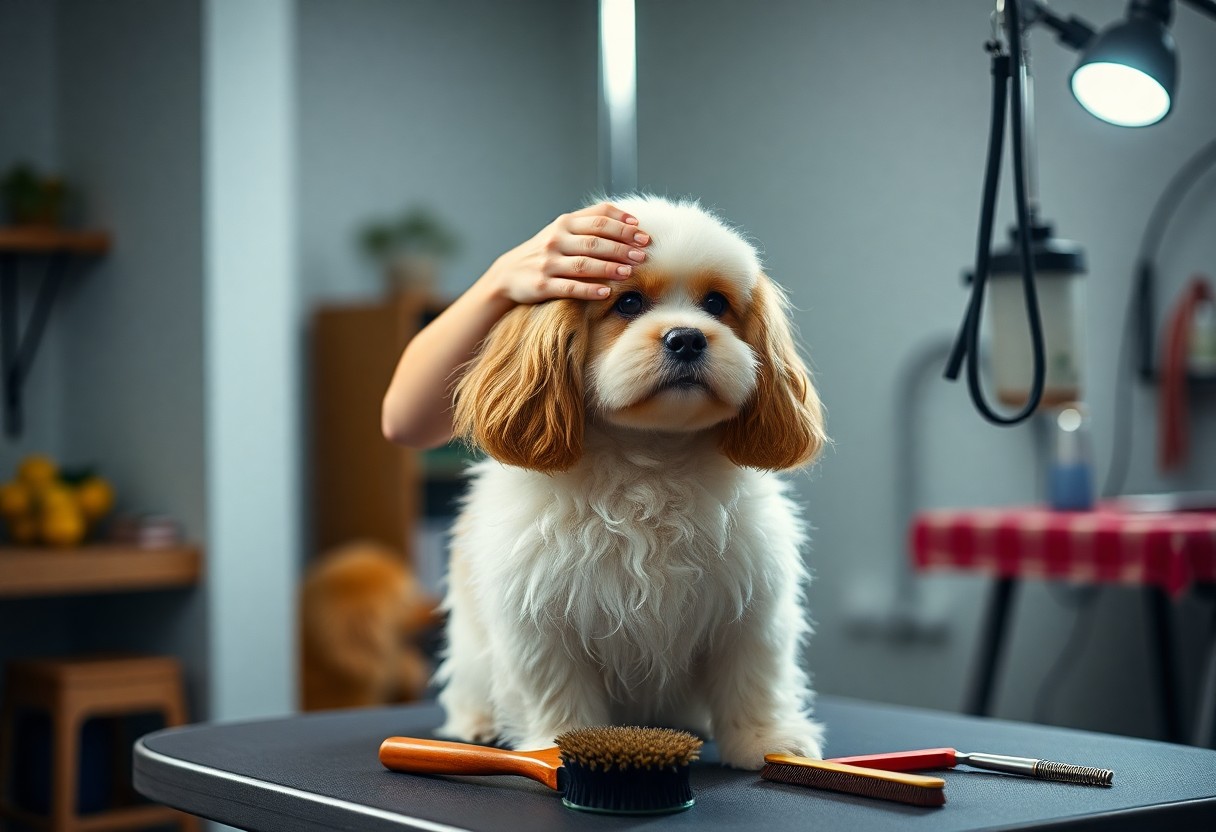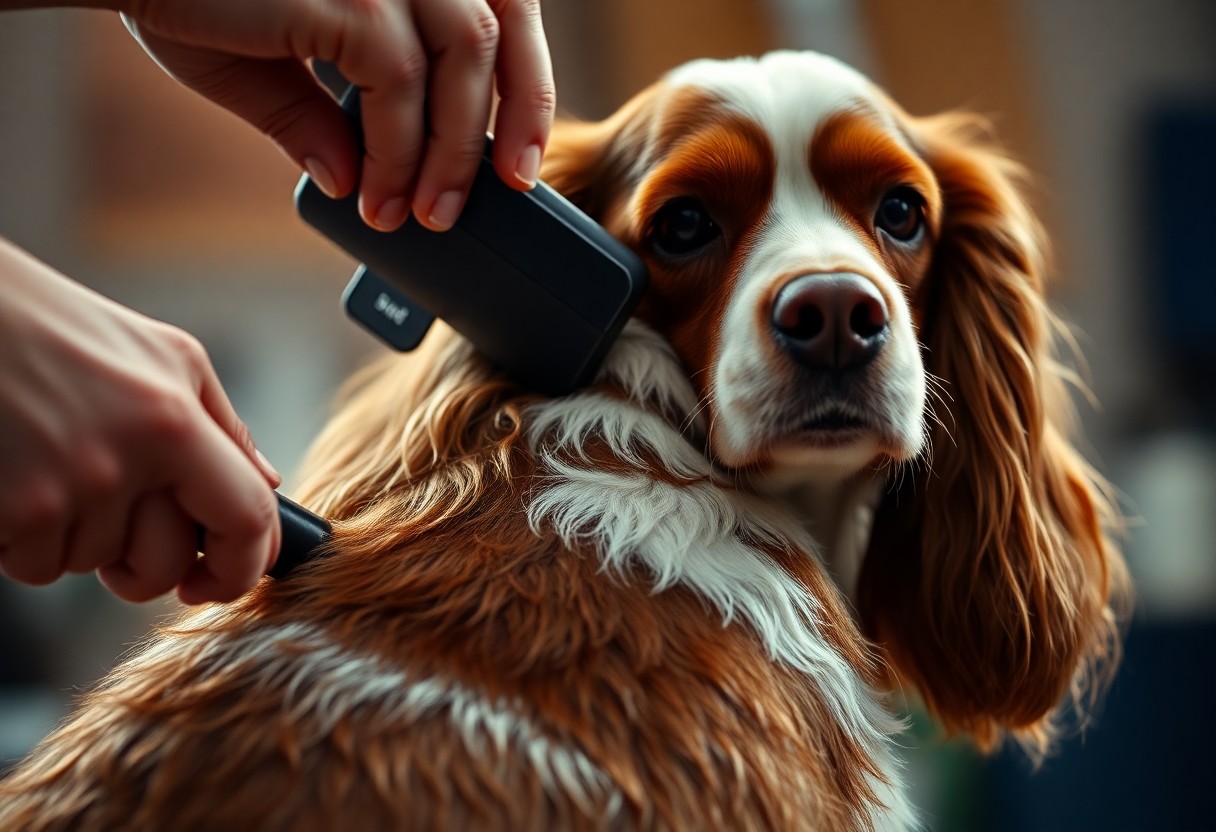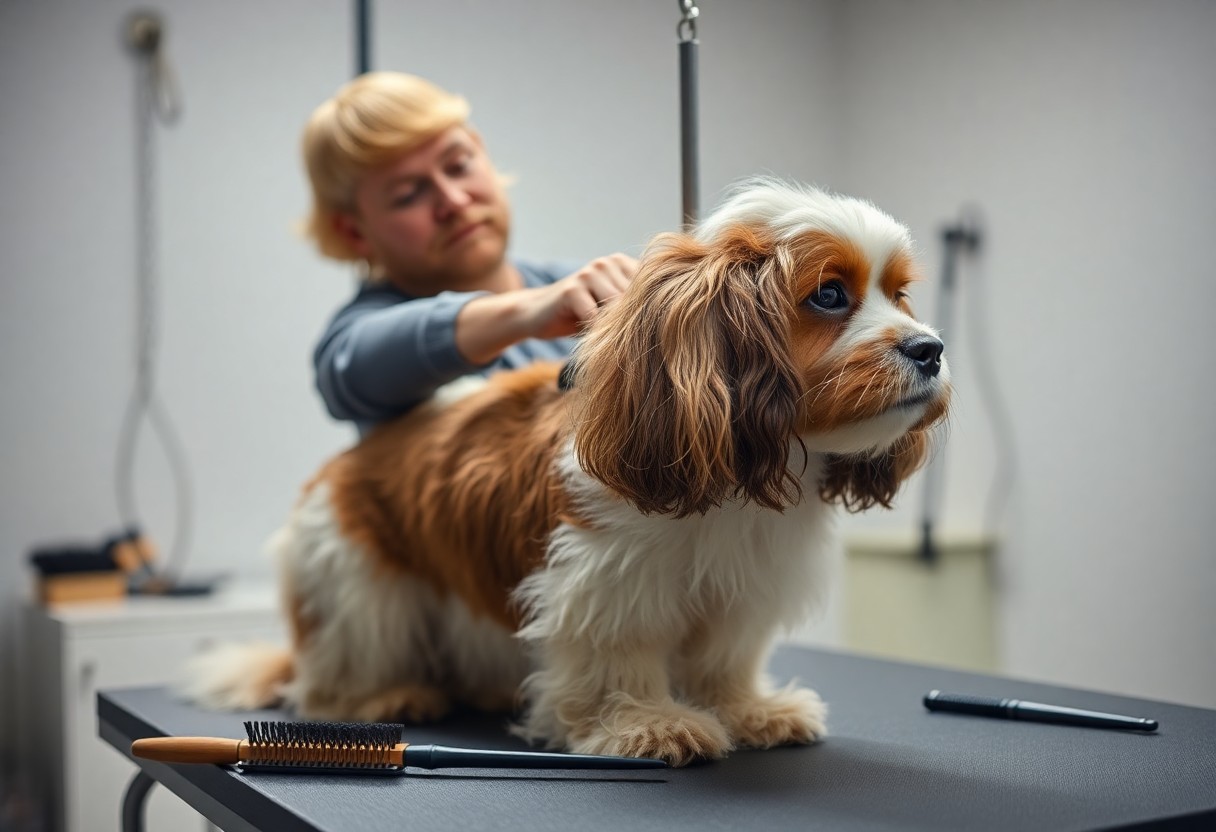This grooming technique is crucial for maintaining your Spaniel’s coat health and appearance. I will guide you through the process step-by-step, showing you how to gently lift and loosen the undercoat to prevent matting and encourage a silky finish. By using the right tools and methods, you can keep your dog comfortable and looking their best. With a bit of practice, you’ll find back brushing becomes an enjoyable part of your regular grooming routine, benefiting both you and your Spaniel.
Key Takeaways:
- Begin by thoroughly wetting your Spaniel’s coat and applying a suitable conditioner to help loosen tangles and mats.
- Use a slicker brush or a specialized back brush, starting from the neck and working down towards the tail with gentle, short strokes to avoid damaging the fur or irritating the skin.
- Pay special attention to areas prone to matting such as behind the ears, under the legs, and around the tail, ensuring you brush regularly to maintain a healthy and tangle-free coat.
The Right Tools for the Task
Essential Grooming Instruments
Having the proper grooming tools makes back brushing your Spaniel easier and more effective. I always start with a slicker brush, which excels at detangling and removing loose undercoat without damaging the topcoat. Alongside it, a wide-toothed comb helps untangle denser mats you might encounter, especially around the ears and feathered legs. Adding a pin brush to your kit is beneficial too—it gently smooths the coat and adds shine. These instruments together create a comprehensive grooming arsenal that keeps your Spaniel comfortable and looking their best.
Selecting the Ideal Brush
Choosing the right brush hinges on your Spaniel’s specific coat type and length. For most English and American Spaniels, a medium to firm-bristled slicker brush provides control during back brushing, effectively tackling the dense undercoat without pulling painfully. The bristles need to be fine enough to pass through the coat but sturdy enough to break up small tangles. I’ve found that brushes measuring about 4 to 5 inches in head width strike a balance between coverage and precision, enabling you to work efficiently through areas prone to matting.
To deepen the understanding, consider how the diameter and flexibility of the bristles play a part. Stiff, tightly spaced bristles penetrate the coat better but can irritate sensitive skin if used too aggressively. Conversely, softer, widely spaced bristles glide blissfully but may miss underlying mats. I often recommend testing a few brushes on a less sensitive part of your Spaniel’s coat first, noting how the dog reacts and how effective the brush is at lifting debris and loose fur. This practical trial ensures you find a brush that suits both the dog’s sensibilities and your grooming style perfectly.
Preparing Your Spaniel for Back Brushing
Setting your Spaniel up for a successful back brushing session takes more than just tools and technique. Getting your dog comfortable and mentally prepared can significantly reduce resistance and stress. I find that starting with a calm atmosphere and dedicating a few moments to relaxation exercises often results in a more cooperative pet. Establishing this groundwork helps in making the grooming routine smooth and enjoyable, reinforcing positive associations with the process over time.
Creating a Calm Grooming Environment
Low lighting and minimal noise contribute greatly to a relaxed atmosphere for your Spaniel. I choose a quiet corner of the house away from active doorways or televisions. Soft background music or white noise can help mask startling sounds. Keeping your grooming tools within easy reach prevents awkward pauses that might unsettle your dog. This steady environment encourages your Spaniel to settle in and stay calm throughout the brushing session.
Techniques for Easing Your Spaniel’s Anxiety
Gentle petting and slow, rhythmic strokes before brushing reduce your Spaniel’s nervousness. Talking softly, using your dog’s name and praising with treats during these moments works particularly well. I also employ gradual exposure to the brush by letting my Spaniel sniff and explore it while rewarding calm behavior, which builds trust around the tool itself.
Diving deeper, I integrate targeted desensitization by initially brushing for just a few seconds, then increasing duration with each grooming session. Timing treats precisely after short brushing helps your Spaniel associate the process with positive outcomes. Additionally, applying slight pressure with a soft brush simulates the brushing sensation without discomfort, which lowers anxiety even in dogs prone to nervousness. Repeating these steps consistently fosters your Spaniel’s confidence and cooperation leading to stress-free grooming experiences.
Mastering the Back Brushing Technique
Back brushing a Spaniel involves more than just sweeping through the coat; it requires an understanding of hair growth and layering. I focus on brushing opposite to the hair’s natural lay, carefully lifting matted sections with a slicker brush to gently detangle without damaging the fur. This method promotes better coat volume and prevents future matting, especially in thicker areas around the chest and ears. You can learn additional tips at How to groom a Spaniel.
Step-by-Step Guide to Effective Back Brushing
| Step | Action |
| 1. Preparation | Begin with a clean, dry coat to reduce snagging. |
| 2. Direction | Brush gently opposite the direction of hair growth. |
| 3. Tools | Use a slicker brush for tangles and a comb for smoothing. |
| 4. Sections | Work in manageable sections to ensure thorough grooming. |
| 5. Finishing | Switch to brushing with the hair’s grain for a polished look. |
Common Mistakes to Avoid During the Process
Applying too much pressure while back brushing can cause discomfort and even skin irritation in your Spaniel. I often see owners rush through the process, which can lead to missed mats and uneven grooming. Another misstep is neglecting to separate the coat into sections; working on the entire back at once makes it harder to untangle knots effectively and can damage the fur. Taking your time and working carefully ensures a healthier, shinier coat with fewer grooming battles.
Post-Brushing Care
After back brushing your Spaniel, I focus on gently detangling any stubborn knots and managing shedding to keep their coat smooth and healthy. A quick run-through with a quality dematting comb can save you from painful tangles next time and reduce loose hairs around the house. I often recommend watching 🐾BENEFITS OF BACK BRUSHING🐾 (this video is kind of a … for insights that highlight how these small steps can really extend the life and look of your Spaniel’s coat.
Detangling and De-shedding Strategies
I approach detangling with patience, using a wide-tooth comb to loosen any mats gently from root to tip, always starting at the ends to avoid breaking the hair. For de-shedding, I employ a slicker brush or a fine-toothed rake tailored for Spaniels, which helps lift and remove loose undercoat hair without irritating the skin. Combining these tools with short, frequent grooming sessions minimizes discomfort and keeps your Spaniel’s fur manageable and tangle-free.
Maintaining a Healthy Coat Between Grooming Sessions
You can lengthen the time between professional grooming visits by incorporating routine at-home care, like regular brushing and spot checks for debris or dirt. Feeding your Spaniel a diet rich in omega-3 fatty acids supports coat shine and skin health from the inside out, reducing dryness and flakiness. I often suggest supplementing meals with fish oil or flaxseed oil, but always coordinate with your vet for proper dosage.
Adding to this, maintaining a healthy coat involves understanding environmental factors that affect your Spaniel’s fur. Seasonal changes usually mean more shedding, so adapt your brushing frequency accordingly to prevent excessive matting and distribute natural oils evenly. Limiting your Spaniel’s exposure to harsh elements like chlorinated pools or salt-treated roads also protects hair integrity between grooming sessions.
Understanding Your Spaniel’s Coat Needs
Your Spaniel’s coat is a dynamic part of their overall health and appearance, requiring specific care tailored to its unique texture and growth patterns. Recognizing the natural thickness, waviness, and seasonal shedding tendencies helps you tailor your brushing approach. Pay special attention to the feathered areas behind the ears and legs, where mats are most likely to develop. Consistent observation allows you to catch changes early and adjust grooming techniques, ensuring your Spaniel’s coat remains healthy, shiny, and free of tangles.
Seasonal Coat Changes and Adjustments
Spaniels typically experience noticeable shedding as seasons change, especially from winter to spring and again in the fall. During these periods, their undercoat thickens or thins to regulate temperature, making back brushing more frequent and thorough to remove loose hairs and prevent mats. Increasing brush speed and duration helps manage the denser undercoat in spring while adjusting to lighter sessions in colder months to avoid over-stripping natural oils.
Identifying Signs of Coat Health Issues
Spotting dullness, excessive brittleness, or patches of hair thinning can indicate underlying health concerns beyond routine grooming needs. Persistent scratching, redness, or inflammation alongside irregular shedding patterns may point toward allergies, parasites, or skin infections. Early detection through careful coat inspection helps you intervene with appropriate medical or dietary adjustments to restore your Spaniel’s comfortable, vibrant coat.
Diving deeper, consistent monitoring for abnormal flakes resembling dandruff or unusual odors can also reveal fungal or bacterial infections that may not be immediately visible. Examining the skin beneath mats or dense feathering ensures no hidden hotspots develop from constant irritation. Consulting with a veterinarian upon noticing sores, bumps, or sudden changes in coat texture helps determine whether supplements, medicated shampoos, or targeted treatments are necessary to maintain your Spaniel’s coat health.
Summing up
Upon reflecting on how to back brush a Spaniel, I understand that it involves using a slicker brush to gently brush the coat against its natural direction, helping to lift and remove loose fur and prevent mats. You should be gentle but thorough, focusing on areas prone to tangles like behind the ears and under the legs. By regularly back brushing, you maintain your Spaniel’s coat health and shine, making grooming a positive experience for both you and your dog.
FAQ
Q: What tools do I need to back brush my Spaniel effectively?
A: To back brush a Spaniel properly, you will need a slicker brush, a comb with both wide and fine teeth, and possibly a detangling spray if your dog’s coat is particularly prone to mats. The slicker brush helps to lift and tease out the undercoat, while the comb smooths the hair and removes any remaining knots. Starting with clean, dry fur makes the process easier and more effective.
Q: How often should back brushing be done on a Spaniel’s coat?
A: It is generally recommended to back brush your Spaniel once or twice a week, depending on their activity level and coat condition. This frequency helps prevent mats and tangling, keeps the coat healthy, and promotes air circulation to the skin. During shedding season or if your dog spends a lot of time outdoors, more frequent brushing may be necessary to manage loose hair and debris.
Q: What is the correct technique to back brush a Spaniel without causing discomfort?
A: When back brushing your Spaniel, start by gently lifting the coat with the slicker brush in the opposite direction of hair growth, working in small sections. Use light to moderate pressure to avoid irritating the skin. After teasing out the undercoat, follow up with a comb to smooth the hair back into place. Always be attentive to your dog’s reactions and stop if they show signgs of discomfort to ensure the grooming process is pleasant for them.


